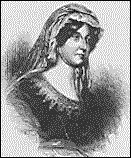



|
Lady Nairne was an astute collector of song and wrote some of Scotland's best-known songs, yet today there are few people that are familiar with her work. It doesn't help that some of her songs and prose have have been attributed to Robert Burns, James Hogg or Walter Scott.
She was born Carolina Oliphant, at Gask House, Perthshire on 16th August 1766. She had three sisters and two brothers, and fortunately, her father was a progressive thinker for his time as he belived in education for girls as well as boys. Her father, Laurence Oliphant, and her mother's family, the Robertsons of Struan, were fierce supporters of the Jacobite movement. Both her father and grandfather had to leave Scotland after Culloden. Their la nds were bought by relatives in the ensuing sales of forfeited estates. Her father suffered in poor health, brought on by his experiences whilst in exile, and to cheer him and her uncle, Duncan Robertson, Chief of Struan, she composed Jacobite songs and set them to old tunes. Charlie is my Darling, Will Ye no Come Back Again, and The Hundred Pipers are examples of this. In her younger years, she was pretty, energetic, and had a keen fondness for dancing. Niel Gow, the famous fiddler, was a contemporary, and they no doubt crossed paths. It was at this time that she adapted popular melodies with new lyrics. The original lyrics would have been considered much too crude for society folk. These included The Laird o' Cockpen, The County Meeting, and The Pleughman. On June 2nd, 1806, at age 41, she married her second cousin, Major William Murray Nairne, and they remained in Edinburgh until his death in 1830. It was upon coming to Edinburgh that she became involved in her lifelong project to preserve and foster the songs of Scotland. In those days, it was not considered proper for ladies of her place in society to dabble in what she herself called "this queer trade of song-writing". Her attempts at keeping her hobby a secret included not telling her husband, publishing her books anonymously, or under the nom-de-plume: Mrs. Bogan of Bogan. Much of her work was contributed in this form, to Robert Purdie's The Scottish Minstrel, 1821-24, in six volumes. When she went to visit him, she would wear an old, veiled cloak, in the hopes she would not be recognized. In 1824, following George IV's visit to Edinburgh in 1822 and Walter Scott's endless petitioning, Parliament restored the forfeited Jacobite peerages and Major Nairne regained the family Barony, and she and her husband became Baron and Baroness Nairne. Baron Nairne died in 1830, and from then on, she travelled quite extensively with her invalid son, who was born in 1808, and her great niece. First, she went to Bristol, then Ireland, and then travelled widely on the Continent. Her son died in Brussels in 1837, and she finally relented to her relatives' pleas to return to Scotland in 1845. Tired and sick, she came back to her home in Gask to die on October 26, 1845, at age 79. She was buried wit hin the new chapel which had been completed only days earlier. Two years after her death, a posthumous collection of verse, Lays of Strathearn, was prepared by her sister, but this time her name subscribed to the book. A granite cross was erected to her memory in the grounds of Gask House. Altogether, she wrote or adapted nearly 100 songs and poems in her lifelong endeavor. Lady Carolina Nairne deserves recognition today, because not only did she help to preserve many Scottish tunes, but also, at a time whe n women's talents were expected to be merely domestic, she managed to do her own thing. Her creative ability, the secret part of her life, never interfered with her position as a society lady. Lady Carolina Nairne has been sadly neglected, but to her we owe immense gratitude, for, without her, much of the Scottish musical heritage would have been lost. Some of this information comes from the Town of Gask, which was her home. |

